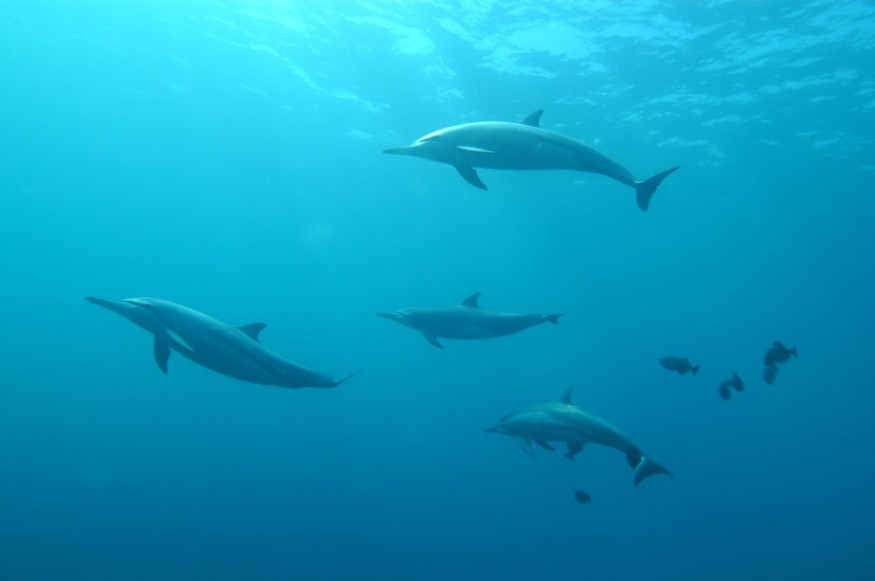A dolphin with "thumbs" was discovered by scientists in the waters of the Gulf of Corinth off the Greece coast, according to reports this week. The extremely rare dolphin was spotted by researchers from the Pelagos Cetacean Research Institute which spotted the unique marine animal twice this summer.
It remains a mystery if other pod members also have thumb-like flippers. However, it is clear that this is the first time the researchers observed the bizarre morphology of the animal while monitoring dolphins along the Greek coast for decades.
There are several dolphin species living in the Gulf of Corinth, including the common dolphin (Delphinus delphis), Risso's dolphin (Grampus griseus), and striped dolphin (Stenella coeruleoalba). The species identified with thumbs is a striped dolphin, which consists of 1,300 individuals in the Gulf of Corinth.
The Greek gulf is located between mainland Greece and the Peloponnese peninsula. While scientists have not linked climate change, pollution, or other ecological catastrophes to the unprecedented discovery, experts suspect that the dolphin in question likely suffers from a genetic defect.
Dolphin with Thumbs

In a post by the page 'My Dolphin Club' on the social media platform X, formerly called Twitter, two photos show the dolphin with thumbs and the caption says it is a product of 15 million years of evolution. The post garnered almost 100 reposts and more than 200 likes as of Wednesday, December 12.
🧵ΣΠΑΝΙΟ ΔΕΛΦΙΝΙ ΜΕ ΕΜΦΑΝΕΙΣ ΑΝΤΙΧΕΙΡΕΣ ΣΤΟΝ ΚΟΡΙΝΘΙΑΚΟ!
— My Dolphin Club (@MyDolphinClub1) November 15, 2023
15 εκατομμύρια χρόνια εξέλιξης μπροστά στα μάτια μας.
Το Ινστιτούτο Κητολογικών Ερευνών Πέλαγος μελετά τα δελφίνια πάνω από 25 χρόνια και για άλλη μια φορά ανακάλυψαν κάτι εξαιρετικά σπάνιο: Δελφίνι με εμφανείς αντίχειρες! pic.twitter.com/02S4YXYvoS
Researchers took photographs of the animal, which was spotted in recent months while the team was conducting boat surveys along the Greek coast. It was also the first time that scientists saw the dolphin with apparent hands in the 30 years of marine surveying in the open sea, as well as in studies that monitor stranded dolphins along the Greece coast.
Alexandros Frantzis, the president and scientific coordinator of the Pelagos Cetacean Research Institute, reported that despite the unusual shape of the dolphin's flipper, the marine mammal still kept up with its pod. It still engaged in activities like bow-riding, leaping, swimming, and playing with fellow dolphins, as cited by local media reporting.
Potential Genetic Defect
Since the condition of the Greece dolphin is extremely rare, experts associate the morphological condition with a potential genetic defect. It was reported that a professor from Northeast Ohio University, named Lisa Noelle Cooper, also agreed that the dolphin's unusual flipper is likely caused by its genetic makeup.
According to the Dolphin Research Center, dolphins also have fingers where the interior of their pectoral fins has a skeletal structure like a human arm and hand. In addition, they have a humerus that is complete with a ball and socket joint, a radius and ulna, and a complete hand structure; which includes five phalanges or finger bones.
However, these features are not as visible as humans and other terrestrial mammals. Yet, some scientists believe that many of these internal physiological structures could be evidence that dolphins and whales evolved from a terrestrial ancestor.
Related Article: 10 Disturbing Facts About Dolphins You'll Wish You Never Knew!
© 2025 NatureWorldNews.com All rights reserved. Do not reproduce without permission.





